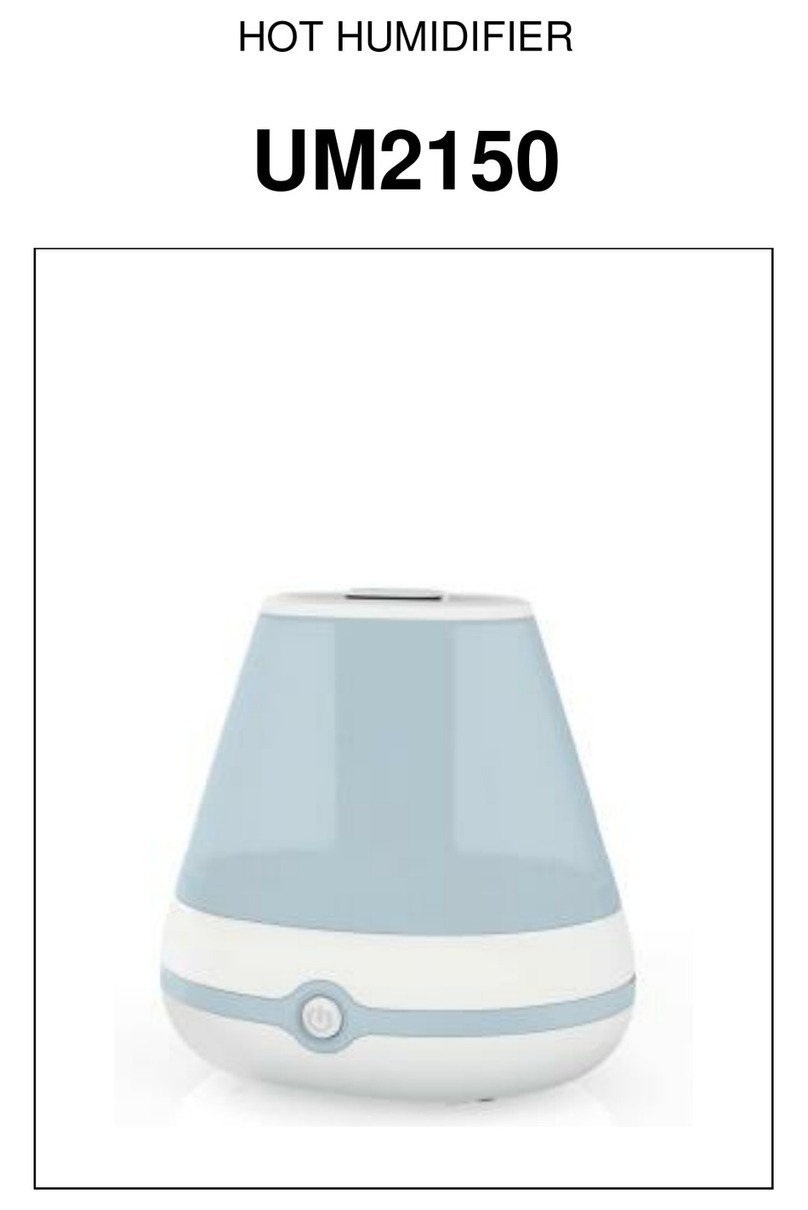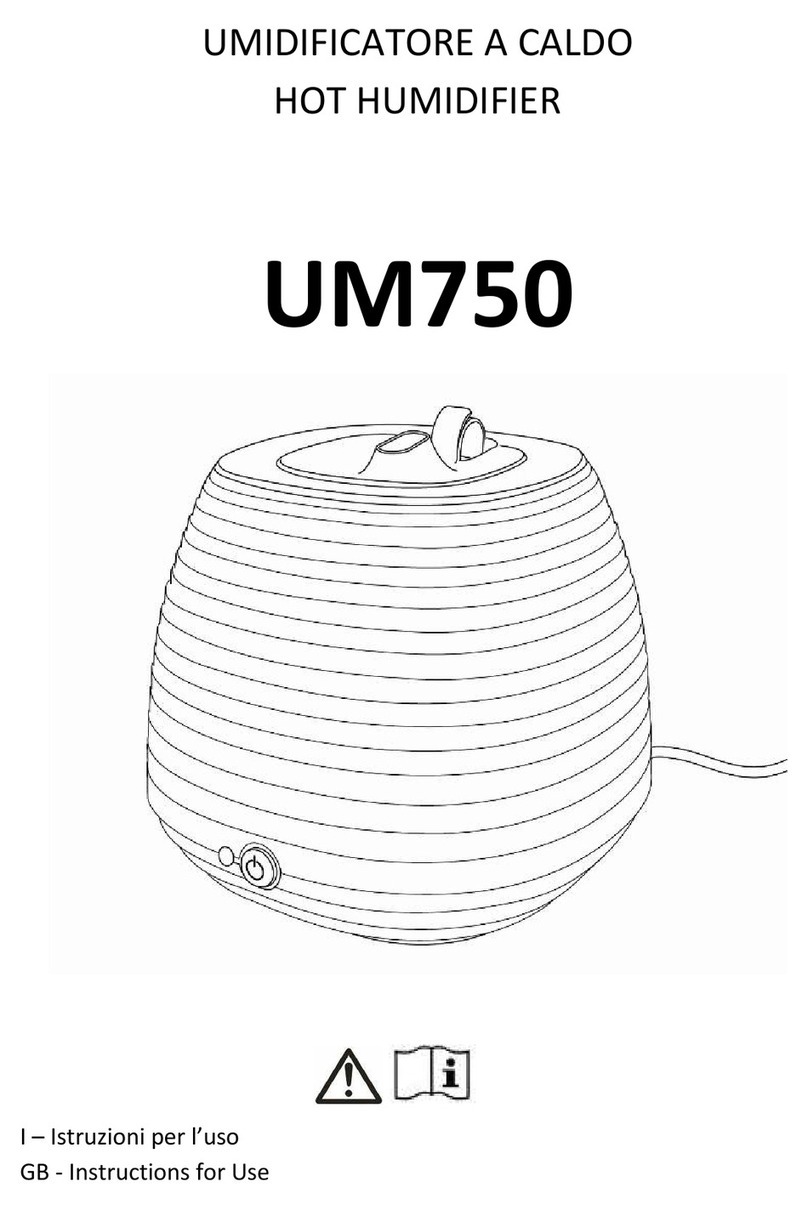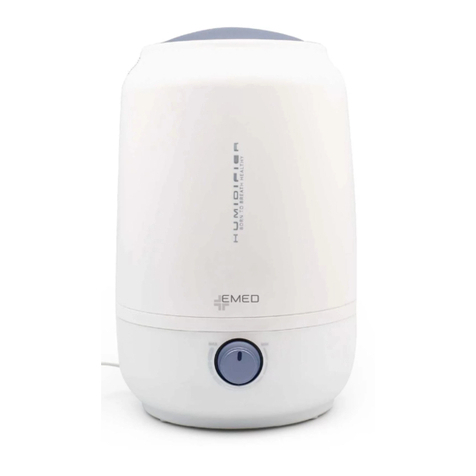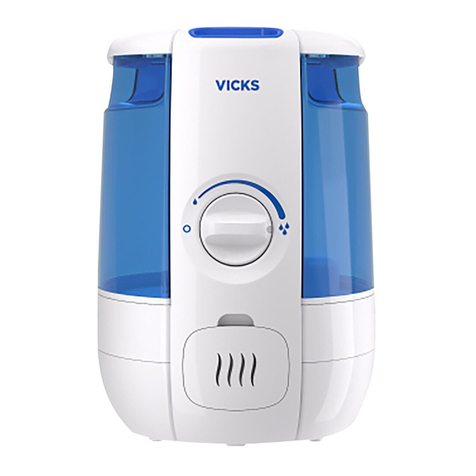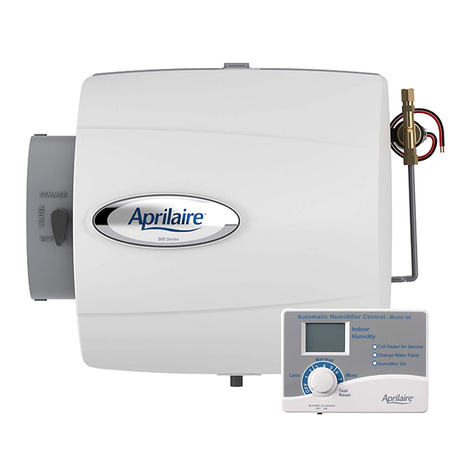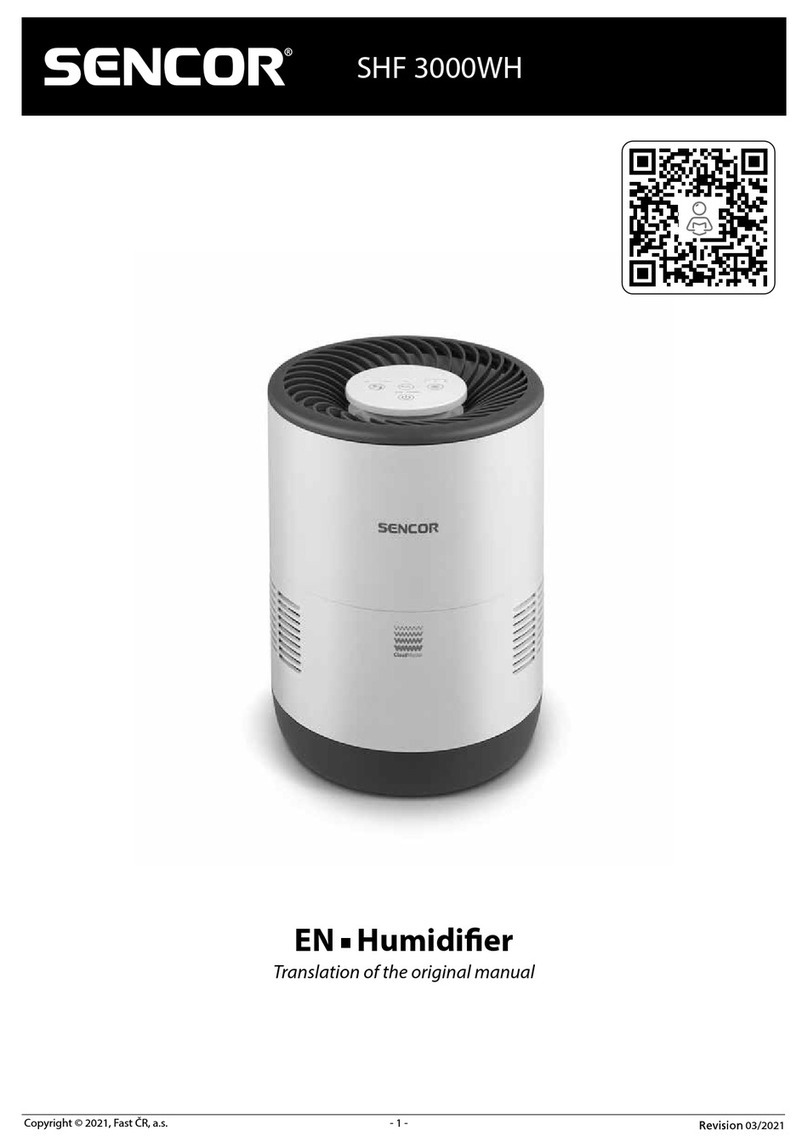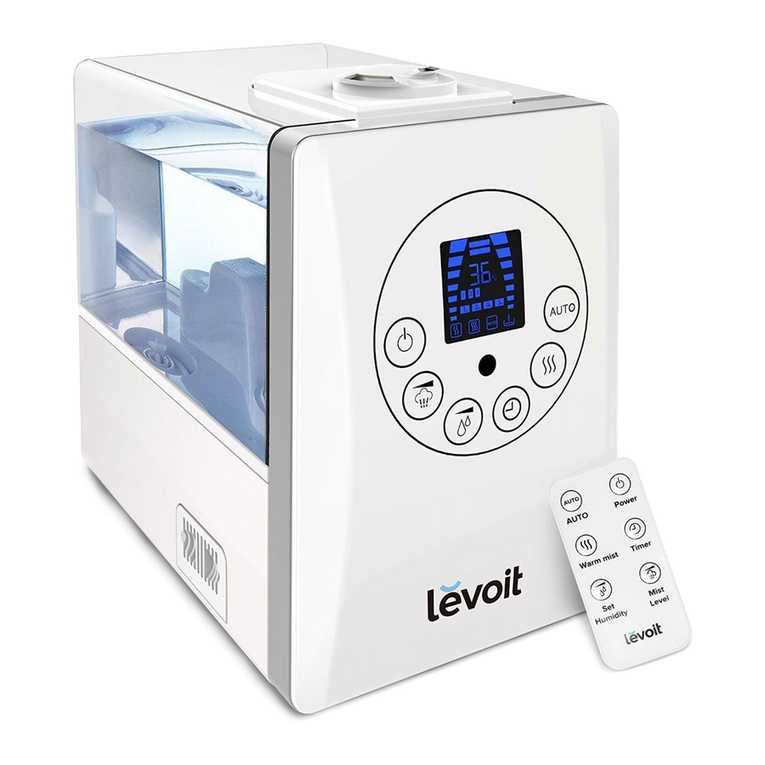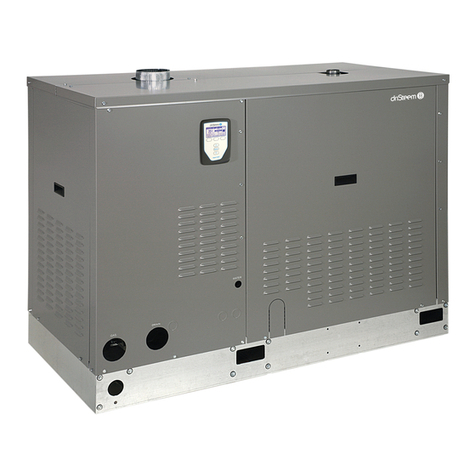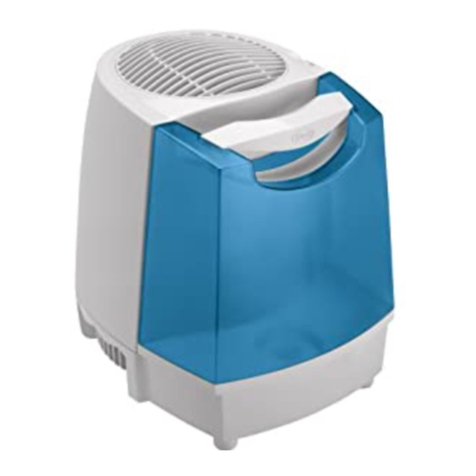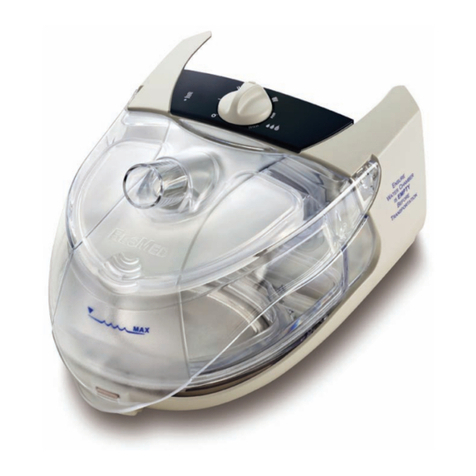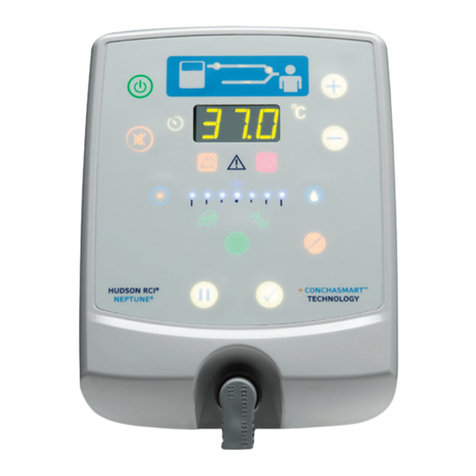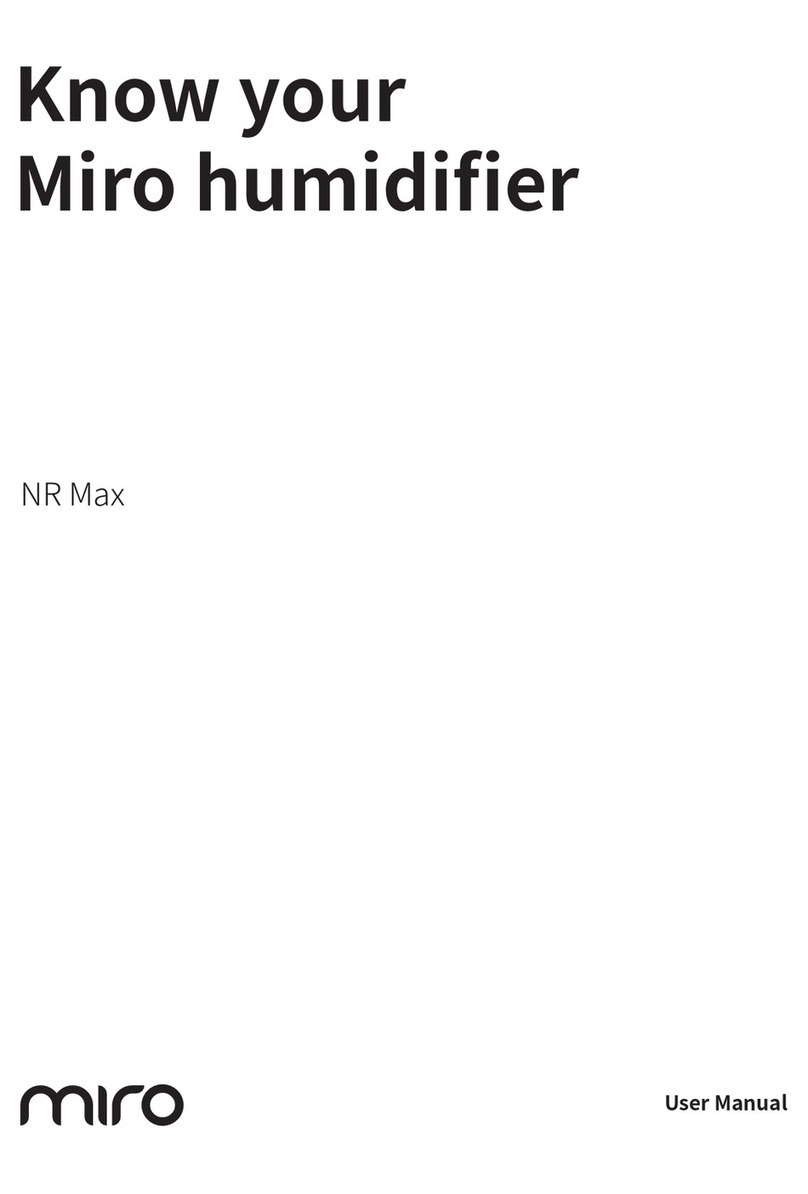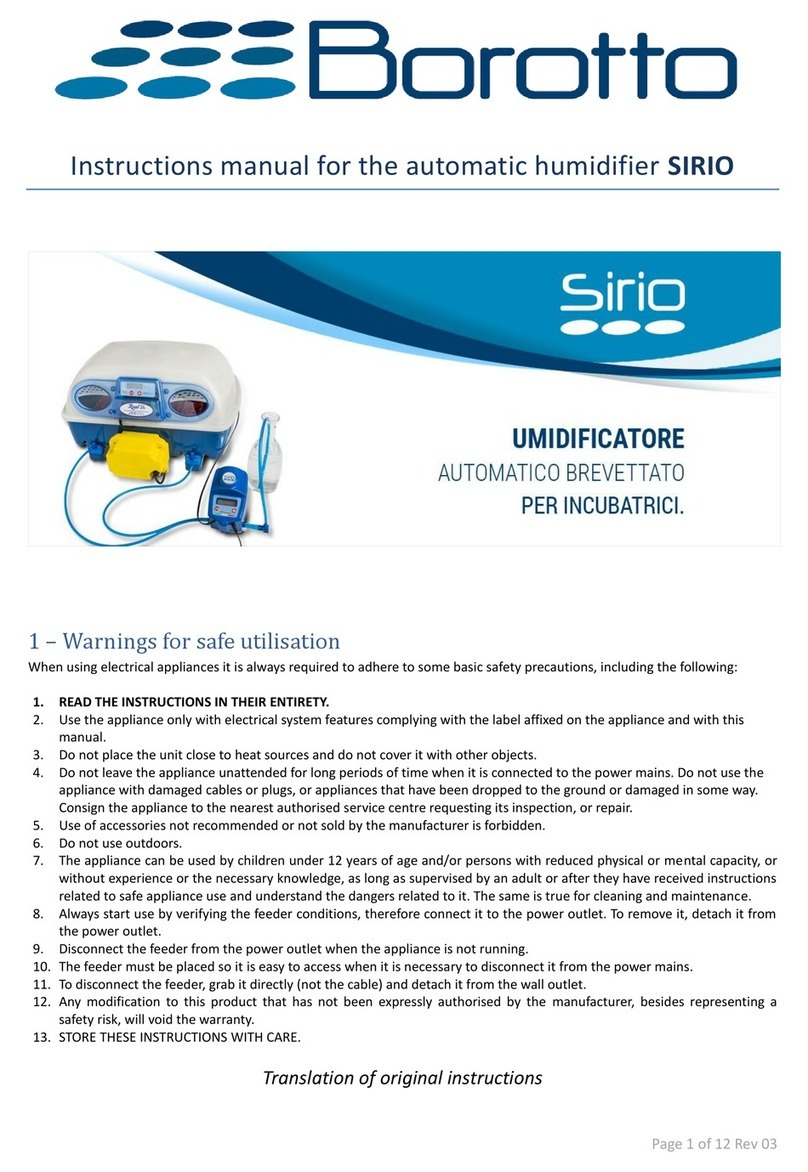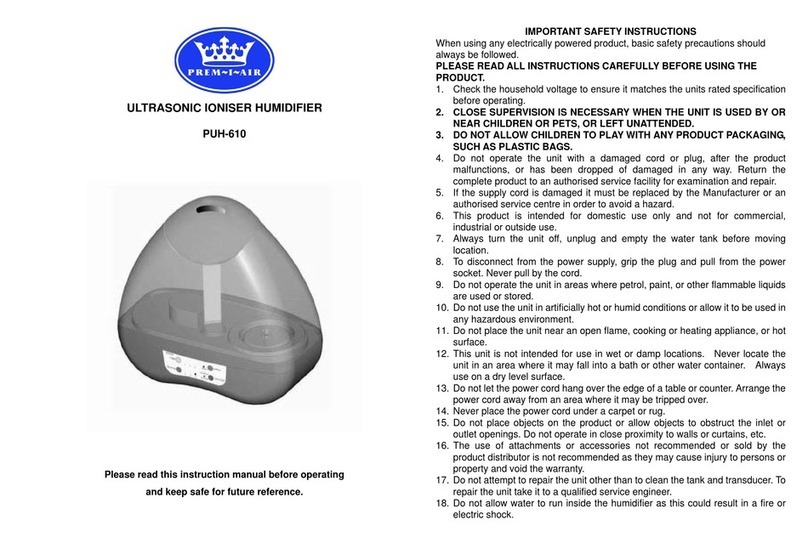Emed UM1450 User manual

1
UMIDIFICATORE A FREDDO
COLD MIST HUMIDIFIER
mod. UM1450
GB ) Instructions for Use
Please read these instructions carefully before use and keep them for future reference.

2
FIG. A
-
FIG. B
FIG. C
1
3
5
4
6
7
9
8
2

3
FIG. D
FIG. E
FIG. F
Max 0,9 Lt

4
FIG. G
FIG. H
FIG. I

5
EN – Cold Humidifier
Package Contents
Humidifier
Power Cord
Instruction Book
For the environment recyclable packaging material
has
been used where possible
Cold humidifier UM1450 exploits high frequency vibrations (called ultrasound), to nebulize cold
water: the nebulization does not cause burns, do not change the temperature of the room and is
silent. For these reasons the humidifier UM1450 turns out to be ideal for the humidification of
rooms where there are children.
The correctly humidity’s degree of the environment helps to maintain the natural protective
functions of the nasal mucous membranes and respiratory tract allowing greater defense against
bacteria and particulate pollutants.
For the welfare of the child, before turning on the humidifier, carefully check the temperature and
the relative humidity of the environment in which it is located according to the values shown in the
table below and comparing them with a hygrometer (values refer to a temperature of about
18/20°C).
Healthy child
40
-
60%
Child with cold and/or cough
60
-
70%
Asthmatic child
35
-
50%
Description of the main components of the unit (Fig. A):
1. On (I) / Off (O) switch
2. Water level
3. Steam outlet
4. Removable tank lid with filling hole
5. Water tank
6. Nebulisation chamber and nebuliser unit (transducer)
7. Product power connector
8. Mains adapter
9. Ventilating grilles
General warnings
1. This electrical appliance is not intended to be used by persons (including children)
with impaired physical, sensorial or mental conditions, or lacking in experience or
knowledge, unless they may make use of surveillance or training regarding the use
of the appliance by means of an intermediary figure who is to be held responsible
for their safety.
2. Never leave the power adapter (8) inserted in the electrical socket when the unit is
not being used or when it is unattended.
3. This appliance must only be used for the purpose for which it was designed,
“humidifier for home use”. Any other use is considered improper and therefore
dangerous. Elettroplastica cannot be held liable for any damages caused by
improper, erroneous or unreasonable use.
4. This product is not a toy. Keep the unit, the steam outlet (4) and power adapter (8)
out of reach of children.

6
5. As soon as the unit is removed from its packaging, ensure that it is intact and that
there is no visible damage that may have been caused by transportation. In case
of doubt, do not use the appliance and contact a technically competent personnel
or dealer.
6. Keep all packaging components (plastic bags, boxes, cardboard boxes, etc.) out of
reach of children.
7. Before connecting the appliance, make sure the information on the power data
plate (8) is compatible with your electricity distribution network.
8. Connect the appliance to a socket that is easily accessible only by an adult.
9. Do not place the appliance on delicate surfaces or surfaces which are sensitive to
water and moisture.
10. Position the appliance only on hard, flat and stable surfaces within the reach of
children.
11. For best operation, position the appliance at a height of at least 70-100cm from the
floor.
12. 12. Verify that the steam outlet (3) is not directed towards furniture, curtains,
shelves, appliances or objects affected by water and/or moisture. Attention!
During normal operation of the appliance, the floor near the exit of the spray may
be wet because of condensation of water mist.
13. Do not obstruct the ventilating grilles (9) located under the machine with cloths and
other objects. Attention! Their obstruction could lead to overheating of the internal
electric circuits.
14. Never add salt to the water contained in water tank (5), on the steam outlet (3), in
the tank or in the nebulizer unit (transducer) (6) as doing so could damage the unit
irreparably.
15. The appliance must never be switched on without water. Always check for the
presence of water before switching the appliance on for use.
16. Any replacement of the mains adapter (8) must be carried out with another one of
the same type and same electrical characteristics.
17. Before performing any cleaning or maintenance operation, ensure that the unit is
turned off and the power adapter (8) is disconnected from the socket on the
product.
18. Do not use accessories, spare parts or components not provided/supplied by the
manufacturer.
19. This appliance does not contain repairable parts and can only be opened with
special tools. Any possible repair must be carried out only by technically
competent personnel.
20. The use of any electrical appliance requires compliance with some basic rules:
- Never touch the unit with wet or humid hands.
- Do not pull the power adapter (8) to detach it from the socket on the product.
- Never leave the appliance exposed to weathering (rain, sun, etc.).
- Keep the unit and the power adapter (8) away from heat sources.
- Never immerse the appliance in water or other liquid.
- In case of failure and / or malfunction of the unit, turn it off by unplugging the
connector (7) from the device and the mains adapter (8) from the wall outlet,
do not try to touch it, but contact a technically competent staff or dealer.
- Do not touch the appliance if it is accidentally dropped in water. Immediately
turn the power off, lowering the general electrical system switch in your home
and immediately disconnect the power adapter (8) from the wall socket before
touching the unit. Do not reuse the unit later, but contact technically
competent personnel or retailer.
21. Do not open or move the humidifier while it is running.

7
22. The appliance must be thoroughly cleaned and dried after each operating cycle.
23. If the unit is not used for an extended period of time, the water tank (5) and
nebulizer unit (6) must be rinsed and dried before being replaced.
24. Before starting up the appliance, it is advisable to carefully rinse the following parts
with clean drinking water, the nebulizer unit (6), the water tank (5) and the steam
outlet (3).
25. If you decide not to use the device anymore, it is recommended, after
disconnecting the mains adapter (8) from the wall socket, to make it inoperative by
cutting the pin that normally fits into the power connector (7).
26. Do not move, lift, tilt, or perform any cleaning or maintenance when the humidifier
is in use or connected to the mains.
27. Do not dispose this product as common municipal waste; make the separate
collection of rubbish as electrical equipment / electronic equipment (WEEE) as
required by applicable laws and guidelines.
28. Pay attention: when the unit is in operation do not lift the tank (5) of the humidifier
and make sure it is correctly positioned.
29. Children should be supervised to ensure that they do not play with the appliance.
30. Do not store the humidifier with water inside it, especially in environments with
extreme temperatures.
31. To avoid the risk of fire, do not pass the power adapter cable (8) under rugs or
near radiators, stoves and heaters.
32. Do not use plug adapters, multiple sockets and / or extensions.
33. Do not touch the transducer with your hands or tools.
34. If you have doubts about the interpretation of the contents of this instruction
manual, contact your dealer.
35. Never remove the plug from the socket by pulling the power cord.
ATTENTION! Always use drinking water previously boiled and cooled down to at
least 40 ° C, both to fill the water tank (5) for normal use, both to perform the daily
and weekly cleaning operations, as described in the instruction manual . In this way
you avoid the proliferation of germs and bacteria
s
.
HOW TO USE
Preliminary operations
• Verify that the device is perfectly clean, that the on/off switch (1) is in the off
position (O) and that the power adapter (8) is not connected to the mains.
• Position the appliance in its selected position, about70-100cm from the floor, in
compliance with specified precautions detailed in the General Warnings
paragraph.
• Press the locking tabs on the tank lid (4) to remove it (Fig. B).
• Fill the water tank (5) with water that has been previously boiled drinking water and
cooled down to at least 40°C taking care not to exceed maximum level (Fig. C).
Then replace the tank lid (4) in its original position.

8
Operation
• Connect the power adapter pin (8) to the connector (7) located at the back of the appliance.
Then, connect the adapter (8) to a home mains socket (Fig. D).
• Switch on the appliance, pushing the on/off switch (1) to position (I). The unit on indicator
light (2) will light up and the appliance will begin to nebulise (Fig. E).
• The tank lid (4) is equipped with a hole which allows the topping up: to add water in the
humidifier, turn off the product by pressing the power switch and disconnect the adapter to the
power socket. Use a small pitcher to pour water through the refilling hole, taking care not to
exceed the maximum level indicated on the side of the water tank (5) (Fig. F).
• The humidifier is equipped with an internal device which allows a nebulising cycle to be stopped
and fan operation when water inside the water tank (5) is finished.
Attention! The product stops nebulising, leaving residual water in the water tank (5). Be careful
not to shake or tilt the appliance to avoid spills that could affect product operation. See section on
emptying.
• When the water runs out, the unit on indicator light (2) will turn off to indicate that the product is
no longer in operation.
• To reset the nebulisation cycle, fill the water tank as indicated in the previous paragraphs.
Nebulisation will automatically re-start (Fig. C).
• To completely switch off the appliance, once again press the on/off switch (1) (Fig. E).
ATTENTION! Never add aromatics substances or balsamic oil to the water contained
in the tank as the product and the spray group could be irreparably damaged.
CLEANING AND MAINTENANCE
ATTENZIONE!! Before cleaning or carrying out maintenance work, always switch off
the unit by means of the switch (1) and disconnect the power adapter (8) from the
electrical outlet.
Daily cleaning
In order to avoid/minimise the possible formation of bacteria or limeCold Stone, you must always
carry out daily appliance cleaning according to the following instructions:
1. Remove the tank lid (4).
2. Remove the nebulisation chamber (6) (Fig. G.)
3. Empty the water tank (5) of any residual water, tilting the product and draining the water out of
the product (Fig. H).
4. Rinse the water tank (5) a few times, allowing the water to fully pour out as indicated in point 3
of this chapter.
5. Rinse the steam outlet (3) a few times.
6. After having removed all water, carefully dry with a dry cloth, passing it also gently over the tank
(5) on the nebuliser unit (transducer) (6) and on the steam outlet (3) (Fig. I).
7. If the appliance is not used after the daily cleaning, wipe all parts of the unit immediately, then
store in a dry and sheltered place.

9
Attention!!
Avoid cleaning the water tank (5) with strong detergents, abrasives, alcohol,
solvents or similar products, which can cause irreparable damage.
Do not place the unit directly under running water.
Keep the power adapter (8) and ventilating grilles (9) far from water.
Do not clean the transducer with tools and/or chemicals or abrasives.
Weekly cleaning.
Outside the unit.
Clean the outside parts of the appliance with a soft cloth slightly dampened with water.
Do not use abrasive products, detergents, alcohol, solvents or similar products, otherwise the
surfaces of the unit may be permanently damaged.
Inside the unit.
During normal use of the appliance, because of the salts in the water, scale deposits may form on
the nebuliser unit (6) and in the water tank (5). This scaling could form more or less quickly
according to the type of water hardness and frequency of use of the appliance. The higher the
water hardness, the faster the formation of deposits.
Scaling decreases performance, increases noise and may impede normal operation of the
appliance.
We recommend performing weekly cleaning in addition to daily cleaning, as follows:
1. Repeat operations from the “Daily cleaning” paragraph.
2. Fill the water tank (5) with a solution of water and white vinegar in equal parts to the maximum
level indicated on the side of the water tank. Let sit for at least 4 hours (preferably for a night).
3. Rinse thoroughly several times with water that has been previously boiled drinking water and let
cool to at least 40°C and dry with a soft cloth, rubbing gently.
4. If necessary, repeat the above operations until the calcium deposits have been fully removed.
Attention!!
• Do not place the unit directly under running water.
• When the humidifier is not used for an extended period of time, after
cleaning, dry the water tank (5),the nebulisation chamber and the nebuliser unit
(transducer) (6) and the steam outlet (3).
• Keep the power outlet (7) and ventilating grilles (9) far from water.
• Do not scrape the transducer with tools and do not use chemicals or abrasives
to clean it.

10
TROUBLESHOOTING
Problem Solution
•If the humidifier does not work •Check that the power adapter pin is
plugged into the power plug (7) and that the
power adapter (8) is connected to the
socket (Fig. D).
•Check that the switch (1) is on position (I).
•Check that there is sufficient water in the
water tank
(5)
•The unit on indicator light (2) is on and
there is no leakage of air without
emission of mist.
•Check if there are calcium deposits on the
nebuliser unit and the transducer (6).
•Check that there is water in the water tank
(5)
.
•Strange odour •Perform normal cleaning operations.
•Aerate the water tank (5) in a cool place for
12 hours
.
TECHNICAL SPECIFICATIONS
Model:
UM1450
Nominal characteristics: 110 - 240V~ 50/60Hz
Ultrasound transducer frequency:
1,7 MHz
Po
wer:
15
W
Water tank
capacity:
about
0,9 L
Nebulising capacity:
a
bout
50
-
80 ml/h
Average autonomy: 6 - 7 hours
Noise: Lower than 45 dB
Isolation classification: AC/DC Class II – Class Product III
Weight: 2,5 kg
Dimensions: 279 x 211 x 139 mm
Environmental conditions for storage Room temperature: +10 ÷ +70 C°
Relative humidity
: 10 %÷ 90 %
Manufacturer Elettroplastica S.p.A - via del Commercio, 1 – 25039 Travagliato (BS) Italy
EC DECLARATION OF CONFORMITY:
This humidifier ELY UM1450 complies with the essential requirements and other relevant provisions of Directives
2004/108/EC (EMC) and 2006/95/EC (electrical safety). A copy of the EC declaration can be requested from
manufacturer Elettroplastica S.p.A. – Via del Commercio 1, 25039 Travagliato (BS), Italy.

11
SIMBOLS KEY
Double insulation
Appliance complies with the essential requirements of applicable EC Directives
ATTENTION!
Instructions for use
Read the instructions for use
For indoor use only
Do not dispose of this appliance or its components as normal urban refuse. Dispose of them at an appropriate
differentiated collection point, as requested by the laws in force in each country.
THIS PRODUCT IS IN CONFORMITY WITH THE EUROPEAN DIRECTIVE EU 2002/96/ EC. The crossed bin
symbol on the appliance indicates that the product, at the end of its life, must be disposed of separately
from domestic waste, either by taking it to a separate waste disposal site for electric and electronic appliances
or by returning it to your dealer when you buy another similar appliance. The user is responsible for taking the
appliance to a special waste disposal site at the end of its life. If the disused appliance is collected correctly as
separate waste, it can be recycled, treated and disposed of ecologically; this avoids a negative impact on both
the environment and health, and contributes towards the recycling of the product’s materials. Illegal dumping of
the product by the user involves administrative sanctions referred to in D. lgs. n. 22/1997 (art. 50 and following
of Legislative Decree 22/97).For further information regarding the waste disposal services available, contact
your local waste disposal agency or the shop where you bought the appliance.
Manufacturer
Elettroplastica S.p.A - via del Commercio, 1 – 25039 Travagliato (BS) Italy
Fabbricato in Cina - Made in China

1
UMIDIFICATORE A FREDDO
COLD MIST HUMIDIFIER
mod. UM1450
I) Istruzioni per l’uso
Leggere attentamente prima dell’uso e conservare queste istruzioni per riferimento futuro
GB ) Instructions for Use
Please read these instructions carefully before use and keep them for future reference.

2
FIG. A
-
FIG. B
FIG. C
1
3
5
4
6
7
9
8
2

3
FIG. D
FIG. E
FIG. F
Max 0,9 Lt

4
FIG. G
FIG. H
FIG. I

5
I - Umidificatore a freddo
Contenuto della confezione
Umidificatore
Cavo di alimentazione
Manuale d’uso
Per il rispetto dell’ambiente dove possibile è stato
utilizzato materiale di confezionamento riciclabile.
L’umidificatore a freddo UM1450 sfrutta vibrazioni ad altissima frequenza (dette ultrasuoni), per
nebulizzare acqua fredda: la nebulizzazione a freddo non provoca scottature, non modifica la
temperatura della stanza ed è silenziosa. Per questi motivi l’umidificatore UM1450 risulta essere
ideale per l’umidificazione dei locali in cui sono presenti i bambini.
Il giusto grado di umidità dell’ambiente contribuisce a mantenere le funzioni protettive naturali
delle mucose nasali e delle vie respiratorie permettendo una maggiore difesa dai batteri e dalle
particelle inquinanti.
Per il benessere del bambino, prima di accendere l’umidificatore, verificate attentamente la
temperatura e l’umidità relativa dell’ambiente in cui si trova seguendo i valori riportati qui di
seguito in tabella e confrontandoli con un igrometro (valori riferiti ad una temperatura ambiente di
circa 18/20°C)
B
ambino sano
40
-
60%
B
ambino con
malattie da raffreddamento
60
-
70%
B
ambino asmatico
35
-
50%
Descrizione delle caratteristiche principali del prodotto (Fig. A):
1. Interruttore acceso I/ spento O
2. Indicazione livello acqua
3. Bocchettone uscita vapore
4. Coperchio tanica removibile con foro per riempimento
5. Tanica acqua
6. Camera di nebulizzazione e gruppo nebulizzatore (trasduttore)
7. Connettore alimentazione prodotto
8. Adattatore di rete
9. Griglie di aerazione
Avvertenze
1. Questo apparecchio elettrico non è da intendersi adatto all’uso da parte di persone (inclusi i
bambini) con ridotte capacità fisiche, sensoriali o mentali, o prive di esperienza e
conoscenza, a meno che queste siano supervisionate od istruite riguardo al corretto uso
dell’apparecchio da una persona responsabile per la loro sicurezza.
2. Non lasciare mai l’adattatore di rete (8) inserito nella presa di corrente quando l'apparecchio
non è in funzione o quando è incustodito.
3. Questo apparecchio dovrà essere destinato solo all'uso per il quale è stato espressamente
concepito: umidificatore per ambienti domestici. Ogni altro uso è da considerarsi improprio e
quindi pericoloso. Elettroplastica non può essere considerata responsabile per eventuali
danni derivanti da usi impropri, erronei ed irragionevoli.
4. Questo prodotto non è un giocattolo. Tenere l'apparecchio, il coperchio tanica (4) e
l’adattatore di rete (8) fuori dalla portata dei bambini.
5. Dopo aver tolto l'apparecchio dall'imballaggio, assicurarsi che si presenti integro senza
visibili danneggiamenti che potrebbero essere stati causati dal trasporto. In caso di dubbio
non utilizzare l'apparecchio e rivolgersi esclusivamente a personale tecnicamente
competente o al rivenditore.
6. Tenere tutti i componenti dell'imballaggio (sacchetti in plastica, scatole, cartoni, ecc.) fuori
dalla portata dei bambini.

6
7. Prima di collegare l'apparecchio accertarsi che i dati di targa di alimentazione (8) siano
corrispondenti a quelli della vostra rete di distribuzione elettrica.
8. Collegare l’apparecchio ad una presa di corrente facilmente accessibile solo da parte di un
adulto.
9. Non posizionare l’apparecchio su superfici delicate o sensibili all’acqua e all’umidità.
10. Posizionare l’apparecchio solo su superfici piane e stabili non accessibili a bambini.
11. Per un migliore funzionamento posizionare l’apparecchio ad un'altezza di almeno 70 -100 cm
dal pavimento.
12. Verificare che la bocchetta di uscita del vapore (3) non sia indirizzata verso mobili, tende,
mensole, apparecchi elettrici od oggetti sensibili all’acqua e/o all’umidità. Attenzione!
Durante il normale funzionamento dell’apparecchio, il piano in prossimità dell’uscita del
nebulizzato potrebbe risultare bagnato a causa della condensazione dell’acqua nebulizzata.
13. Non ostruire le griglie di aerazione (9), poste sotto l’apparecchio, con panni ed oggetti vari.
Attenzione! La loro ostruzione potrebbe causare il surriscaldamento dei circuiti elettrici
interni.
14. Non aggiungere mai sale all’acqua contenuta nella tanica dell’acqua (5) e sul bocchettone di
uscita (3) nella vasca e gruppo nebulizzatore (trasduttore) (6) in quanto l'apparecchio
potrebbe danneggiarsi irreparabilmente.
15. L’apparecchio non deve essere acceso senza acqua. Verificare sempre la presenza di acqua
prima dell’accensione dell’apparecchio per il suo utilizzo.
16. L'eventuale sostituzione dell’adattatore di rete (8) deve essere effettuata con altro di tipo
identico e medesime caratteristiche elettriche.
17. Prima di effettuare qualsiasi operazione di pulizia o manutenzione assicurarsi che
l’apparecchio sia spento e che l’adattatore (8) disinserito dalla relativa presa sul prodotto.
18. Non utilizzare accessori, ricambi o componenti non previsti/forniti dal produttore.
19. Questo apparecchio non contiene parti riparabili. L’apertura dell’apparecchio è possibile solo
per mezzo di utensili speciali. Ogni eventuale riparazione deve essere effettuata
esclusivamente da personale tecnico competente.
20. L'uso di un qualsiasi apparecchio elettrico comporta l'osservanza di alcune regole
fondamentali:
•Non toccare mai l'apparecchio con mani bagnate o umide.
•Non tirare il cavo di alimentazione (8) per staccarlo dalla presa di corrente.
•Non lasciare esposto l'apparecchio ad agenti atmosferici (pioggia, sole, ecc.).
•Tenere l'apparecchio e l’adattatore di rete (8) lontano da fonti di calore.
•Non immergere mai l'apparecchio in acqua o in altro liquido.
•In caso di guasto e/o cattivo funzionamento dell'apparecchio, spegnerlo staccando il
connettore (7) dall’apparecchio e l’adattatore di rete (8) dalla presa di corrente, non
tentare di manometterlo ma rivolgersi esclusivamente a personale tecnicamente
competente o al rivenditore.
•Non toccare l'apparecchio se questo cade accidentalmente in acqua; togliere
immediatamente la corrente abbassando la leva dell’interruttore generale dell’impianto
elettrico della vostra abitazione e staccare subito l’adattatore di rete (8) dalla presa di
corrente prima di toccare l’apparecchio. Non utilizzarlo successivamente e rivolgersi a
personale tecnicamente competente o al rivenditore.
21. Con l'apparecchio in funzione non aprite o spostate l’umidificatore.
22. L'apparecchio deve essere accuratamente pulito ed asciugato al termine di ogni ciclo di
funzionamento.
23. Se l'apparecchio non viene usato per un periodo di tempo prolungato, la tanica d’acqua (5) e
il gruppo nebulizzatore (6) devono essere risciacquati e asciugati prima di essere riposti.
24. Prima di mettere in funzione l'apparecchio consigliamo di risciacquare accuratamente con
acqua potabile fredda, pulita, le seguenti parti: il gruppo nebulizzatore (6), la tanica
dell’acqua (5) e il bocchettone d’uscita del nebulizzato (3).
25. Allorché si decida di non utilizzare più l’apparecchio, si raccomanda, dopo aver staccato
l’adattatore di rete (8) dalla presa di corrente, di renderlo inoperante tagliando lo spinotto che
normalmente si inserisce nel connettore di alimentazione (7).

7
26. Non spostare, sollevare, inclinare o effettuare operazioni di pulizia o manutenzione
dell’umidificatore quando è in funzione o è collegato alla rete elettrica.
27. Non smaltire questo prodotto come normale rifiuto urbano, operare la raccolta differenziata
come apparecchio elettrico/elettronico (RAEE) come richiesto dalle vigenti leggi e direttive
CE.
28. Quando l’apparecchio è in funzione, prestare la massima attenzione, non sollevare la tanica
(5) dell’umidificatore ed assicurarsi che sia correttamente posizionata.
29. I bambini dovrebbero essere supervisionati per assicurarsi che non giochino con
l’apparecchio.
30. Non conservare l’umidificatore con all’interno dell’acqua soprattutto in ambienti con
temperature estreme.
31. Per evitare il rischio di incendi non far passare il cavo dell’adattatore di rete (8) sotto tappeti
o vicino a radiatori, stufe e caloriferi.
32. Non utilizzare adattatori di spina, prese multiple e/o prolunghe.
33. Non toccare il trasduttore con mani o utensili.
34. Se avete dubbi sull’interpretazione del contenuto del presente libretto di istruzioni contattare
il rivenditore.
35. Non sfilare mai la spina dalla presa di corrente tirando il cavo di alimentazione.
ATTENZIONE! Usare sempre acqua potabile precedentemente bollita e lasciata
raffreddare fino ad almeno 40°C, sia per riempire la tanica dell’acqua (5) per l’uso
normale, sia per eseguire le operazioni di pulizia giornaliera e settimanale, come
descritto nel manuale di istruzioni. In questo modo si eviterà la proliferazione di germi
e batteri.
MODALITA D’USO
Operazioni preliminari
•Verificare che l’apparecchio si presenti perfettamente pulito, che l’interruttore di accensione
(1) sia in posizione spento (O)e che l’adattatore di rete (8) non sia collegato alla rete
elettrica.
•Posizionare l’apparecchio nella zona prescelta a circa 70-100 cm di altezza da terra
rispettando le precauzioni specificate nel paragrafo “Avvertenze”.
•Premere sulle linguette di bloccaggio del coperchio tanica (4) per rimuoverlo (Fig. B).
•Riempire la tanica dell’acqua (5) facendo attenzione a non eccedere il livello massimo (Fig.
C)con acqua potabile precedentemente bollita e lasciata raffreddare fino ad almeno 40°C,
quindi riposizionare il coperchio della tanica (4) nella sua posizione originale.
Funzionamento
•Collegare lo spinotto dell’adattatore di rete (8) al connettore (7) posto sul retro
dell’apparecchio, quindi, collegare l’adattatore (8) ad una presa di corrente della rete
domestica (Fig. D).
•Accendere l’apparecchio spingendo l’interruttore di accensione (1) in posizione (I); si
illuminerà una luce led. L’apparecchio incomincerà a nebulizzare (3) (Fig. E).
•Il coperchio removibile (4) è dotato di un foro per il riempimento: per aggiungere acqua
all’umidificatore spegnere il prodotto premendo l’interruttore e scollegando l’alimentatore
dalla presa elettrica, dotarsi di una piccola brocca e versarla tramite questa apertura facendo
attenzione a non superare il livello massimo indicato sul lato della tanica (Fig. F).
•L’umidificatore è provvisto di un dispositivo interno che consente l’interruzione del ciclo di
nebulizzazione e del funzionamento della ventola quando l’acqua all’interno della tanica
raggiunge il livello minimo.
Attenzione! Il prodotto termina di nebulizzare lasciando un residuo d’acqua nella tanica: fare
attenzione a non agitare o inclinare l’apparecchio onde evitare rovesciamenti che potrebbero
compromettere la funzionalità del prodotto. Si veda paragrafo relativo allo svuotamento.

8
•Al termine dell’acqua la luce led si spegnerà per indicare che il prodotto non è più in
funzione.
•Per ripristinare il ciclo di nebulizzazione: procedere al riempimento della tanica come
indicato nei paragrafi precedenti. Quindi accendere l’apparecchio (Fig. C).
•Per spegnere completamente l’apparecchio premere nuovamente l’interruttore (Fig. E).
ATTENZIONE!! Non aggiungere mai sostanze aromatiche o olio balsamico all’acqua
contenuta nella tanica poiché il prodotto e il gruppo di nebulizzazione potrebbero
danneggiarsi irreparabilmente.
SICUREZZA E MANUTENZIONE
ATTENZIONE!! Prima delle operazioni di pulizia/manutenzione/riempimento
dell’apparecchio, spegnere sempre lo stesso mediante l’interruttore (1) e staccare
l’adattatore di rete (8) dalla presa di corrente dell’impianto elettrico.
Pulizia giornaliera
Al fine di evitare/ridurre l’eventuale formazione di batteri o calcare, è necessario effettuare sempre
la pulizia giornaliera dell’apparecchio in accordo alle seguenti istruzioni:
1. Rimuovere il coperchio del prodotto (4).
2. Rimuovere il gruppo della camera di nebulizzazione (6) (Fig. G).
3. Svuotare la tanica (5) dal residuo di acqua inclinando il prodotto e facendo scolare l’acqua
fuori dal prodotto (Fig. H).
4. Risciacquare più volte la tanica (5) facendo scolare completamente l’acqua come indicato al
punto 3 del presente capitolo.
5. Risciacquare più volte il bocchettone di uscita (3)
6. Dopo avere rimosso l’acqua, asciugare accuratamente con un panno asciutto passandolo
delicatamente anche sulla vasca (5) sulla vasca /gruppo nebulizzatore (trasduttore) (6) e sul
bocchettone di uscita (3) (Fig. I).
7. Nel caso l’apparecchio non venga utilizzato, dopo la pulizia giornaliera, asciugare subito tutte
le parti dell’apparecchio quindi riporlo in un luogo asciutto e riparato.
Attenzione!!
Evitare la pulizia della tanica dell’acqua (5) con detergenti aggressivi, prodotti
abrasivi, alcool, solventi o prodotti similari poiché potrebbe danneggiarsi
irreparabilmente.
Non mettere l'apparecchio direttamente sotto il getto d'acqua.
Tenere l’acqua lontana dal cavo di alimentazione (8) e dalle griglie di aerazione (9).
Non pulire il trasduttore con utensili e/o con prodotti chimici o abrasivi.
Pulizia settimanale.
Esterno dell’apparecchio.
Pulire le parti esterne dell’apparecchio utilizzando un panno morbido leggermente inumidito con
acqua.
Non usare prodotti abrasivi, detergenti aggressivi, alcol, solventi o prodotti similari in quanto le
superfici dell’apparecchio si danneggerebbero irrimediabilmente.
Interno dell’apparecchio.
Durante il normale utilizzo dell’apparecchio, a causa dei sali contenuti nell’acqua si potrebbero
formare incrostazioni di calcare sul gruppo di nebulizzatore (6) e nella tanica dell’acqua (5). Tali
incrostazioni, potrebbero formarsi più o meno velocemente in base al tipo di durezza dell’acqua e

9
alla frequenza di utilizzo dell’apparecchio. Maggiore è la durezza dell’acqua e più veloce è la
formazione delle incrostazioni.
Le incrostazioni diminuiscono le prestazioni, aumentano la rumorosità e potrebbero impedire il
normale funzionamento dell’apparecchio; si consiglia pertanto oltre alla pulizia giornaliera, di
eseguire anche quella settimanale come segue:
1. Ripetere le operazioni di cui al paragrafo “Pulizia giornaliera”.
2. Versare nella tanica dell’acqua (5) una soluzione di acqua e aceto bianco in parti uguali, tale
da riempire la stessa fino al livello massimo indicato sul lato della tanica. Lasciare agire per
almeno 4 ore (meglio per una notte).
3. Risciacquare abbondantemente più volte con acqua potabile precedentemente bollita e
lasciata raffreddare fino ad almeno 40°C e asciugare con un panno morbido strofinandolo
delicatamente.
4. Se necessario ripetere le operazioni sopra indicate fino alla rimozione totale dei depositi
calcarei.
Attenzione!!
•Non mettere l'apparecchio direttamente sotto il getto d'acqua.
•Quando l’umidificatore non viene usato per un lungo periodo di tempo,
dopo la pulizia, asciugare la tanica dell’acqua (5), la vasca gruppo nebulizzatore
(trasduttore) (6) e il bocchettone di uscita (3).
•Tenere l’acqua lontana dalla presa di alimentazione (7) e dalle griglie di
aerazione (9).
•Non raschiare il trasduttore con utensili e non utilizzare prodotti chimici o
abrasivi per pulirlo
PROBLEMI E SOLUZIONI
Problema Soluzione
•Se l’umidificatore non funziona •Controllare che lo spinotto del cavo di
alimentazione sia inserito correttamente nel
connettore (7) e che l’adattatore di rete (8)
sia collegato alla presa corrente (fig. D).
•Controllare che l'interruttore (1) sia sulla
posizione acceso (I)
•Controllare che ci sia acqua sufficiente
nella tanica (5)
•Se la spia LED di segnalazione
accensione apparecchio (2) è accesa e
vi è fuoriuscita d’aria senza emissione
di nebulizzato.
•Controllare se c’è deposito di calcare sul
gruppo nebulizzatore e sul trasduttore (6).
•Controllare che ci sia acqua nella tanica
(5)
.
•Odore strano •Effettuare le normali operazioni di pulizia.
•Aerare la tanica dell'acqua (5) in un luogo
fresco per 12 ore
.
Table of contents
Languages:
Other Emed Humidifier manuals

